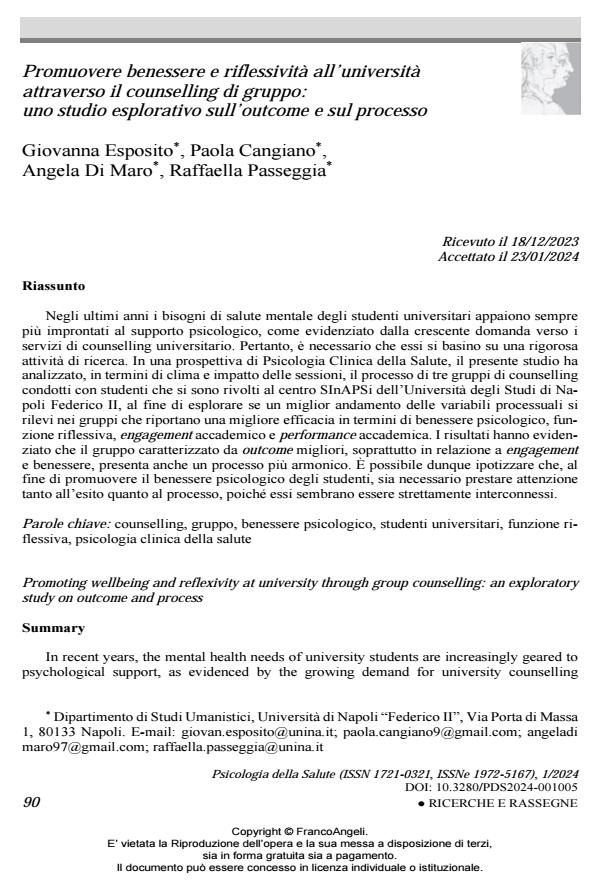Promuovere benessere e riflessività all’università attraverso il counselling di gruppo: uno studio esplorativo sull’outcome e sul processo
Titolo Rivista PSICOLOGIA DELLA SALUTE
Autori/Curatori Giovanna Esposito, Paola Cangiano, Angela Di Maro, Raffaella Passeggia
Anno di pubblicazione 2024 Fascicolo 2024/1
Lingua Italiano Numero pagine 24 P. 90-113 Dimensione file 284 KB
DOI 10.3280/PDS2024-001005
Il DOI è il codice a barre della proprietà intellettuale: per saperne di più
clicca qui
Qui sotto puoi vedere in anteprima la prima pagina di questo articolo.
Se questo articolo ti interessa, lo puoi acquistare (e scaricare in formato pdf) seguendo le facili indicazioni per acquistare il download credit. Acquista Download Credits per scaricare questo Articolo in formato PDF

FrancoAngeli è membro della Publishers International Linking Association, Inc (PILA)associazione indipendente e non profit per facilitare (attraverso i servizi tecnologici implementati da CrossRef.org) l’accesso degli studiosi ai contenuti digitali nelle pubblicazioni professionali e scientifiche
Negli ultimi anni i bisogni di salute mentale degli studenti universitari appaiono sem-pre più improntati al supporto psicologico, come evidenziato dalla crescente domanda verso i servizi di counselling universitario. Pertanto, è necessario che essi si basino su una rigorosa attività di ricerca. In una prospettiva di Psicologia Clinica della Salute, il presente studio ha analizzato, in termini di clima e impatto delle sessioni, il processo di tre gruppi di counselling condotti con studenti che si sono rivolti al centro SInAPSi dell’Università degli Studi di Napoli Federico II, al fine di esplorare se un miglior anda-mento delle variabili processuali si rilevi nei gruppi che riportano una migliore efficacia in termini di benessere psicologico, funzione riflessiva, engagement accademico e per-formance accademica. I risultati hanno evidenziato che il gruppo caratterizzato da out-come migliori, soprattutto in relazione a engagement e benessere, presenta anche un pro-cesso più armonico. È possibile dunque ipotizzare che, al fine di promuovere il benesse-re psicologico degli studenti, sia necessario prestare attenzione tanto all’esito quanto al processo, poiché essi sembrano essere strettamente interconnessi.
Parole chiave:counselling, gruppo, benessere psicologico, studenti universitari, funzione riflessiva, psicologia clinica della salute
Giovanna Esposito, Paola Cangiano, Angela Di Maro, Raffaella Passeggia, Promuovere benessere e riflessività all’università attraverso il counselling di gruppo: uno studio esplorativo sull’outcome e sul processo in "PSICOLOGIA DELLA SALUTE" 1/2024, pp 90-113, DOI: 10.3280/PDS2024-001005